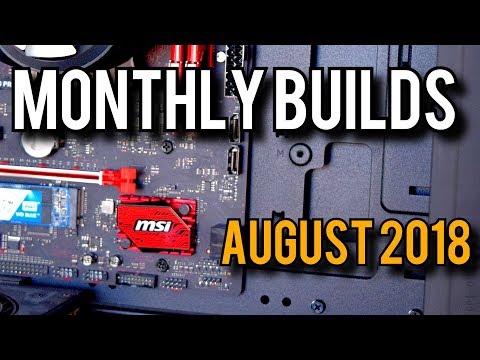
Prices are stabilizing and now is the time to build Howdy howdy guys ponchato here, and welcome to Monthly Builds for August of 2018
In these videos I show you the parts I’d use for building gaming PCs at $500, $750, and $1000 budgets To keep up with new prices and components, I put up a new video every month so be sure to subscribe to stay up to date Before we get to the builds, though, let’s look at some PC industry news China-based Tencent announced its plans to bring its WeGame store (their competitor to Steam) into the international market If you haven’t heard of them, Tencent is a massive multinational conglomerate involved in entertainment, AI, and technology
It’s also the world’s largest investment corporation, so they have plenty of resources to throw at this project Right now WeGame only has around 200 titles on its storefront, but if this international launch goes as planned, that number will likely explode Steam may have some legitimate competition coming soon, and this could turn out to be an interesting fight A handful of Z370 motherboards have received BIOS updates adding compatibility for Intel’s upcoming 8-core 9000-series processors So far only boards with the Z370 chipset, and not others like the H310, have received these updates
It could be that Intel is only allowing the Z370 chipset to support the upcoming processors because those boards have higher VRM requirements than boards that don’t support overclocking, which will be important if the 9000 series processors pull a lot of power And they will, because this is still pretty much the same architecture they’ve been using since 2015 Still on the Intel side of things, there have been rumors that the upcoming i9 processors will actually have a soldered heat spreader, rather than the toothpaste Intel has been using for the past few years This is what the whole “delidding” thing is about – Intel stopped soldering their heat spreaders to their processors and instead just used thermal glue, which dramatically reduced thermal conductivity and as a result, killed overclocking performance The pessimist in me says this isn’t gonna happen, but if Intel actually starts soldering their processors, this great news for PC enthusiasts
On the AMD side of things, in their 2nd quarter investors conference call, CEO Lisa Su (aka Momma Su) said that rollout of 7nm Ryzen processors will only follow the rollout of 7nm EPYC processors – their server counterparts That means we won’t be seeing a 16-core Ryzen processor anytime this year, and likely not until the second half of 2019 Finally, for some gaming-specific news, just one kind-of-funny, kind-of-tragic story Aliens: Colonial Marines was a game launched back in 2013 and got, shall we say, unfavorable reviews The main reason for the horrific response was the alien AI which was, to put it bluntly, very dumb
PC Gamer noted that “aliens would get stuck on the ceiling, fall off walls, and run in circles”, and other reviewers said that the aliens would group together and kind of slowly wander toward the player, making them extremely easy to shoot and not scary at all Well, turns out, the reason the alien AI was so stupid is because of a typo, in one of the game’s ini files A function called “AttachPawnToTether”, was supposed to be initialized by this file but was misspelled The Aliens never had the proper programming, and so the game was panned
All because someone misspelled “tether” with an ‘A’ Whoops Quick note before we get to the builds: if you like this channel and/or you like memes, check out the Discord server! It’s linked in the description below And now that we’re all caught up, let’s look at the builds First up, the $500 build
For the CPU I picked AMD’s Ryzen 3 2200G for $90 This is the most affordable current-generation quad core processor, and because it’s a Ryzen, it’s unlocked and can be overclocked Really the only other competition in the sub-$100 segment is Intel’s G4560 or G5400, and while those two processors are $30 to $40 cheaper, they’re only dual core CPUs with hyper threading At a $500 budget, that performance hit wouldn’t be worth the slight savings in cost For the GPU I went with Nvidia’s GTX 1050 for $130
The 1050 is still pretty much the best budget GPU; GT 1030s are significantly slower, 1050 Tis cost almost a third more for a less than 10% FPS increase, and AMD’s offering at this price, the RX 560, is 5-15% slower on average In fact, at pretty much every budget level, I’d argue the only reason to get an AMD GPU right now is if you have a Freesync monitor, and even then that’s a pretty flimsy reason for deliberately buying a lower performance, yet still as-expensive part The motherboard will be an MSI B350M PRO-VDH for $71 There are cheaper AM4 motherboards, but sacrificing two RAM slots to save $10 is a hefty loss of upgradability with very little in the way of cost savings Regardless, since this board has the B350 chipset, you’ll be able to overclock the 2200G for some free extra performance
For memory I went with the Ballistix Tactical 2x4GB kit for $102 This kit is rated for 2666MHz, which should provide a decent performance improvement for the 2200G since Ryzen processors are so dependent on memory speed For storage, the Western Digital Blue 1TB for $44 For the most part, performance in one hard drive is going to be functionally identical to any other of the same RPM and capacity, especially when compared to SSDs All the same if you need more storage, the 2TB version is only about $15 more
The power supply I picked is the Thermaltake Smart 500 for $35 It’s 80 Plus rated and comes with a 5-year warranty, and in my testing, is actually pretty quiet despite being a budget power supply Finally, for the case, I went with the Rosewill FBM-X1 for $27 This case shows up on my recommendations all the time for two main reasons: it’s cheap, and it’s not horrifically ugly When dealing with lower-end, low-power parts like this, there isn’t much reason to spend a ton on a case with more fans and better airflow
If you’re targeting a specific budget, the performance loss you’ll take by being forced to pick a cheaper CPU or GPU will far outweigh any minor benefit you might get from slightly better cooling Altogether these parts come out just under budget at $499 This is about as low as I’d recommend going for a new gaming computer – below $500 you’ll be making some pretty severe performance sacrifices, and particularly graphic-intensive games might not be playable even on the lowest settings With this build, you’ll be able to run any modern game Click the links in the description to pick up these parts for yourself
Now if you can swing a bit higher budget, I’d recommend going with the next build At $750 it’s at the price to performance sweet spot and it’ll give you the best bang for your buck you can get today For the CPU I went with AMD’s Ryzen 5 2400G for $160 This is the next step up from the 2200G used in the $500 build, and comes with a few enhancements The most important changes are the addition of multithreading, which gives the 2400G 8 threads instead of 4, and a higher base frequency of 3
6GHz Like all Ryzen processors it’s also unlocked, so you can overclock it for some free extra performance The GPU I picked is Nvidia’s GTX 1060 6GB for $280 GPU prices, at least on the Nvidia side, seem to have stabilized and fortunately current prices allow for the 6 gig 1060 to fit into the $750 budget This card can max out most games at 1080p, run 14440p, and even play games at lower settings at 4K
Since it’s a 120W card it requires a PCIe power connector, but it’s still not a very loud card and is very efficient For the motherboard I picked MSI’s B350M PRO-VDH for $71 I’m reluctant to recommend spending any more on the motherboard than this, because you really don’t gain much in functionality More expensive boards might have nicer designs, or LEDs, but other than better heat sinks there isn’t much to be gained on the higher end outside of aesthetics For memory I went with Corsair’s Vengeance 2x4GB kit for $105
This is a 3000MHz kit which is great since Ryzen processors are very dependent on memory speed 3000 or 3200MHz is typically the fastest memory speed Ryzen processors can reliably run without spending a lot of time tweaking the timings, so this kit is right at the top of still being worth it For this build I actually dropped the SSD and opted to just include the hard drive, a WD Blue 1TB for $44 Accommodating the 2400G and GTX 1060 took priority over slightly better load times and system responsiveness that you’d get from an SSD After all, these are gaming builds, and at the end of the day the primary goal is getting the highest frames per second possible
For the power supply I went with the EVGA 500 W1 for $40 It’s 80 Plus rated, comes with a 120mm fan, and if you register it with EVGA they’re offering an extra two years on the warranty through the end of 2018, bringing it up to 5 years Not bad for a budget power supply Finally, for the case, I went with the classic Cooler Master N200 for $50 It’s all black inside and out, and has a wide open mesh panel on the front for airflow
With components like the 2400G and GTX 1060, cooling is actually a consideration here, and the design of this case is perfect for maximum airflow The N200 comes with a front and rear 120mm fan, and can support a 240mm radiator up front if you decide to go that route All told this build comes out to exactly $750 Between the $500 build and $750 build, I’d recommend going with this one The 2400G and 1060 6 gig are going to provide great longevity and the N200 will continue to be a great platform for upgrading in the future
Click the links in the description to pick up these parts for yourself Last but not least, let’s take a look at the $1000 build For the CPU I picked AMD’s Ryzen 5 2600 for $170 With 6 cores and 12 threads, this is a monster of a mid-to-high end processor It has a 3
4GHz base clock with boost up to 39, and since it’s a Ryzen processor it can be overclocked for potentially massive performance gains The GPU I picked is Nvidia’s GTX 1070 for $420 This is a crazy strong card with 8 GB of memory, and is a huge step up in performance from the 1060: about 40% more FPS on average It’ll easily max out games at 1080p, run most games at high or max settings at 1440p, and even run fairly high settings at 4K
This is going to be a respectable card for several years to come For the motherboard I picked Asus’ Prime B350-Plus for $90 This is a full size ATX motherboard, which means you have access to several more PCIe slots, comes with an M2 slot for an SSD, and 4 RAM slots for upgradability Plus, it has a larger heat sink on the CPU VRM, which is important for keeping temperatures under control if you’ll be overclocking
Memory will come from Corsair, their Vengeance 2x4GB kit for $105 Rated for 3000MHz, this memory will give you plenty of speed to pair with your Ryzen 5 2600 and likely give a bit of headroom in overclocking, something the Ryzen 2000 series handles a lot better than the first gen For the SSD I picked ADATA’s XPG SX6000 for $47 This is an NVMe drive so it offers much higher read and write speeds than a SATA drive, which will translate to faster load times, faster boot times, and overall better system responsiveness Bulk storage goes again to Western Digital with their 1TB Blue drive for $44
As I mentioned before, a larger 2TB drive is only about $15 more, so if you might need the extra space (especially at this budget), it is really not much more expensive Power goes to Corsair’s CX650M for $62 This power supply is 80 Plus Bronze certified for better efficiency over the standard 80 Plus, and has the wonderful feature of being semi-modular That means you only have to plug in the power cables you actually need, which makes cable management significantly easier and keeps your case way more free from clutter Corsair also shows up for the case with their Carbide 200R for $60
This is an ATX mid tower case so it provides a bit more capacity than micro ATX cases; three 525” drive bays and four 35” bays, along with plenty of room for cable management It also comes with a front and rear 120mm fan for respectable cooling right out of the box In total these parts come out to $998
With a Ryzen 5 2600 and GTX 1070, this build will last for a good number of years, and since the AM4 socket is going to be supported until 2020, you’ll be able to significantly upgrade the CPU without needing to replace anything else Click the links in the description to pick up these parts for yourself And that’s it for Monthly Builds of August 2018 If you’re building a PC for the first time, welcome to the community and be sure to check out my build videos to see how it’s done If you’re a veteran and just needed to catch up, I hope these recommendations helped you
If you want to get notified of new videos as soon as they’re up, hit subscribe then click the bell icon to enable notifications So guys if you liked this video hit the like button, if you want to see more hit subscribe, and if you have any questions on these builds, leave them in the comments below Thanks for watching, I hope I helped, and I’ll see you in the next video





